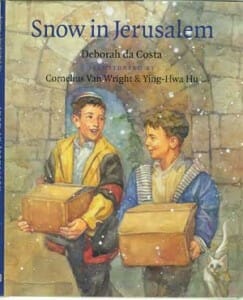 For decades, stories about the Middle East conflict have ebbed and flowed in the news. Despite the historical significance, few primary-aged children living in other regions of the world are aware of this controversy. Most teachers and parents prefer to avoid introducing contentious topics. Few children’s authors have chosen to write on the subject. While searching for a picture book about cats, I accidently come across Deborah da Costa’s award winning book, Snow in Jerusalem. (Albert Whitman & Company, 2001)
For decades, stories about the Middle East conflict have ebbed and flowed in the news. Despite the historical significance, few primary-aged children living in other regions of the world are aware of this controversy. Most teachers and parents prefer to avoid introducing contentious topics. Few children’s authors have chosen to write on the subject. While searching for a picture book about cats, I accidently come across Deborah da Costa’s award winning book, Snow in Jerusalem. (Albert Whitman & Company, 2001)
One of the main characters in this book is a fluffy white cat with blue eyes. She wanders the streets of Jerusalem. By becoming engaged in the stray cat’s journey, the reader learns about the four unique sections of the Old City. The title page includes a simple map that points out the Armenian, Christian, Jewish, and Muslim Quarters.
The neutral cat befriends a Muslim and a Jewish child. Both boys become emotionally attached to the cat. Each feeds it whenever it comes to his respective neighborhood. Toward the end of the story, the wandering cat brings the boys together. They learn that the cat has a litter of kittens. As rare flakes of snow fall on Jerusalem, the boys cooperate. The kittens will be evenly divided. The white cat will split her time between the Jewish and Muslim Quarters of the Old City.
Watercolor illustrations by Cornelius Van Wright and Ying-Hwa Hu provide a glimpse of the four sections. The artists used Uri Yaffe’s photographs to create their muted illustrations. While the pictures are intentionally subdued, readers should be able to recognize symbols, outfits, and structures associated with each group.
The illustrations and the text provide a starting point for discussing the multicultural aspects of the Old City. Modern pictures from the Four Quarters can be used to reinforce some of the obvious differences between the ethnic groups. Learning to acknowledge and accept cultural diversity is the key to the boys’ friendship. Compromise became a possibility when the boys were able to work toward a common goal. A neutral party (the cat) was able to bridge the geographic and cultural gap. Snow in Jerusalem has multicultural messages that should be shared with children.
The book also includes a glossary of Hebrew and Arabic words and an author’s note. Since I am not an authority on life in the Old City, I do not know whether everything stated in the author’s note is still true 13 years later. Even if day-to-day life in the Old City has changed, this delightful multicultural picture book should continue to be read aloud to children.
Honors and Awards
- A Junior Library Guild Selection
- A University of Wisconsin’s Cooperative Children’s Book Center Choice for 2002
- An Association of Jewish Libraries Notable Children’s Book of Jewish Content for 2001
- A Children’s Literature Choice List of Books for 2002
- A Jewish Theological Seminary Notable Book for Younger Readers
- Harold Grinspoon Foundation PJ Library Selection
Related Blogs
Tikvah Means Hope: Charming Classeic for Sukkot
Historical Picture Book- Discovering Jewish and African Roots
Picture Book Recalls Clara Lemlich
Time Traveling Back to the Dreyfus Affair
Check out These Children’s Picture Books- Israel
Bio
Sandra Bornstein is the author of MAY THIS BE THE BEST YEAR OF YOUR LIFE. It is available on Amazon. Sandra’s memoir highlights her living and teaching adventure in Bangalore, India. She is a licensed Colorado teacher who has taught K-12 students in the United States and abroad as well as college level courses. Sandra is married and has four adult sons. The memoir was a finalist in the Travel category for the 2013 Next Generation Indie Book Awards, the 2013 International Book Awards, the 2013 National Indie Book Excellence Awards, 2013 USA Best Book Awards, and a Honorable Mention award in the Multicultural Non-Fiction category for the 2013 Global ebook Awards.
Leave a Reply
You must be logged in to post a comment.